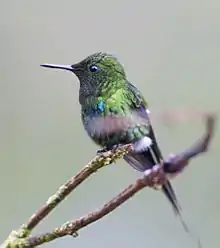Green thorntail
The green thorntail (Discosura conversii) is a small hummingbird that is a resident breeder from Costa Rica to western Ecuador. It occurs at middle elevations from 700–1,400 m (2,300–4,600 ft) but may descend lower early in the wet season. In Costa Rica and Panama it is confined to the Caribbean slopes.
| Green thorntail | |
|---|---|
 | |
| male, Milpe Bird Sanctuary, NW Ecuador | |
.jpg.webp) | |
| female | |
| Scientific classification | |
| Kingdom: | Animalia |
| Phylum: | Chordata |
| Class: | Aves |
| Order: | Apodiformes |
| Family: | Trochilidae |
| Genus: | Discosura |
| Species: | D. conversii |
| Binomial name | |
| Discosura conversii | |
| Synonyms | |
|
Popelairia conversii | |
This is a forest canopy species. The nest is undescribed, but a published image shows a female constructing a nest on a thin branch, so it is presumably similar to other cup nests built by species such as the green-breasted mango. All hummingbirds lay two white eggs incubated by the female alone.
Green thorntail has mainly green upperparts, a white rump band and a blackish lower rump and tail. It weighs just 3 g (0.11 oz). The 10 cm (3.9 in) long male has the long wire-like tail that gives this species its name and green underparts. The 7.5 cm (3.0 in) long female lacks the long tail and has blackish underparts with a green breast band. She has conspicuous white moustaches.
The green thorntail is usually silent, but may give a quiet chip. These birds visit small flowers including those of epiphytes and shrubs, and also take tiny flies and wasps. Breeding males perch on open branches and may give a dive display.
_male_in_flight.jpg.webp) male, Mount Totumas cloud forest, Panama
male, Mount Totumas cloud forest, Panama male
male
References
- BirdLife International (2012). "Discosura conversii". IUCN Red List of Threatened Species. 2012. Retrieved 26 November 2013.CS1 maint: ref=harv (link)
- Stiles and Skutch, A guide to the birds of Costa Rica ISBN 978-0-8014-9600-4
External links
| Wikimedia Commons has media related to Discosura conversii. |
- Green thorntail videos on the Internet Bird Collection
- Green thorntail photo; Article w/RangeMaps InfoNatura NatureServe
